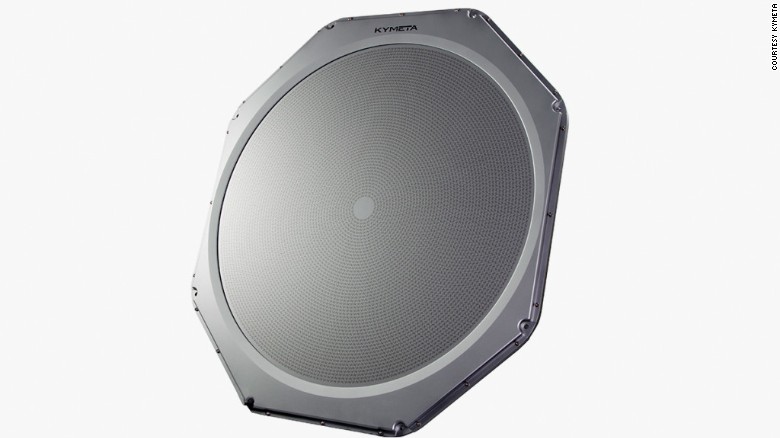
Kymeta's antenna doesn't use moving parts, so it's less than half an inch thick.
(WIRED)There's a big problem with the Wi-Fi on airplanes. Because it's such a wonderful idea, the fact that it rarely works well makes it feel more like an insult than a gift—one you paid for.
This is not the promised land of 21st century work and distraction. Want to stream Netflix? Forget about it. Download that PDF? Sure, just give it 20 minutes.
Part of the problem, says Dr. Nathan Kundtz, is the portion of the radio spectrum the FCC allocates for air-to-ground connectivity, between 300 MHz and 3 GHz.
For in-flight connectivity, "there's only an about 3 MHz-section of that band that's allocated, so there's only so much you can do with that." The answer, then, Kundtz says, is "to open up new types of spectrum." He's talking about far higher frequencies, where things are less crowded. The FCC already allocates some of this territory for these purposes, it's just a matter of tapping into them.
That raises a new issue: To use that frequency, the bunny ears on your grandma's TV or the tennis ball-wearing pole on your car won't do.
You need a more sophisticated, parabolic antenna—i.e., a dish. Such things work great—on anything that isn't approaching the speed of sound.
But that's not the only problem. Airlines are obsessive about adding weight or drag to their airplanes, because those things increase fuel consumption, which cuts into the bottom line. So they're loathe to bolt a metal saucer to the fuselage of their 737s and A320s.
There are options for pulling down that better Wi-Fi. United uses Panasonic antennas on some planes, for example. As the plane flies, the antenna moves to maintain its connection.
The downside is it requires a bigger radome—the covering that protects it in flight—which means more drag and more weight. Selling Wi-Fi to passengers generates revenue, which helps the bottom line, but it's not an ideal solution.
Kundtz says he can do better. He runs Kymeta, a communications company he helped launch after spinning it out of Intellectual Ventures in 2012.
The company's raised $250 million, and its core product is a new kind of antenna—the "mTenna"—which is less than half an inch thick and between 20 and 40 inches in diameter, roughly the size of an extra large pizza.
The key to the Kymeta antenna is that it doesn't have to move to maintain a good connection. Made up of a liquid crystal gap layer between two circuit boards or sheets of glass, it can be electronically reconfigured to point right at the satellite.
Without the need for motors or space to move around, the size of the antenna and the radome can be minimized. "When it's one meter across but only a centimeter thick, that fits very nicely" atop a fuselage, Kundtz says.
The antenna needs so little power, it can run off a USB cable. And Kymeta promises affordability. It's not talking dollar figures yet, but anything that cuts fuel use without cutting Wi-Fi is bound to interest airlines. (Panasonic is working on its own low-profile, electronically-steered antenna, which could be ready as soon as next year.)
And it's coming. This week, Kymeta announced it's working with aerospace supplier Honeywell and satellite provider Inmarsat to develop the flat-panel antenna for use on commercial and business jets. Expect it to be ready in three to five years.
- Source: CNN

No comments:
Post a Comment